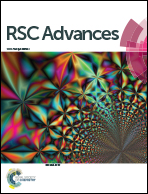N-terminal aromatic tag induced self assembly of tryptophan–arginine rich ultra short sequences and their potent antibacterial activity†
Abstract
Multiple drug resistant (MDR) Staphylococcus aureus is among the most dreaded pathogens for human health in community as well as nosocomial environments. Here we report self assembling ultra short N-terminal modified peptidomimetics based on a template X-W3R4 (where, X = aromatic organic moiety) that show potent activity against multiple MDR S. aureus strains. The active sequences self assemble in water to form nano vesicle (140–190 nm diameter) with positive surface zeta potential and hydrophobic core of Trp residues/N-terminal tags. Further, lethal membrane depolarisation of MRSA cells and a concentration dependent leakage of calcein dye from artificial bacterial mimic membranes established membrane disruptive mode of action for designed sequences. We demonstrate role of N-terminal tag on nature of self assembly and envisage the origin of antibacterial activity to be conformationally aligned nanovesicles which upon interaction lead to disruption of bacterial cells. The designed cell selective nanovesicles may further be exploited towards in vivo applications as antibacterial agent alone or as vehicles for systemic anti-infective therapy.


 Please wait while we load your content...
Please wait while we load your content...